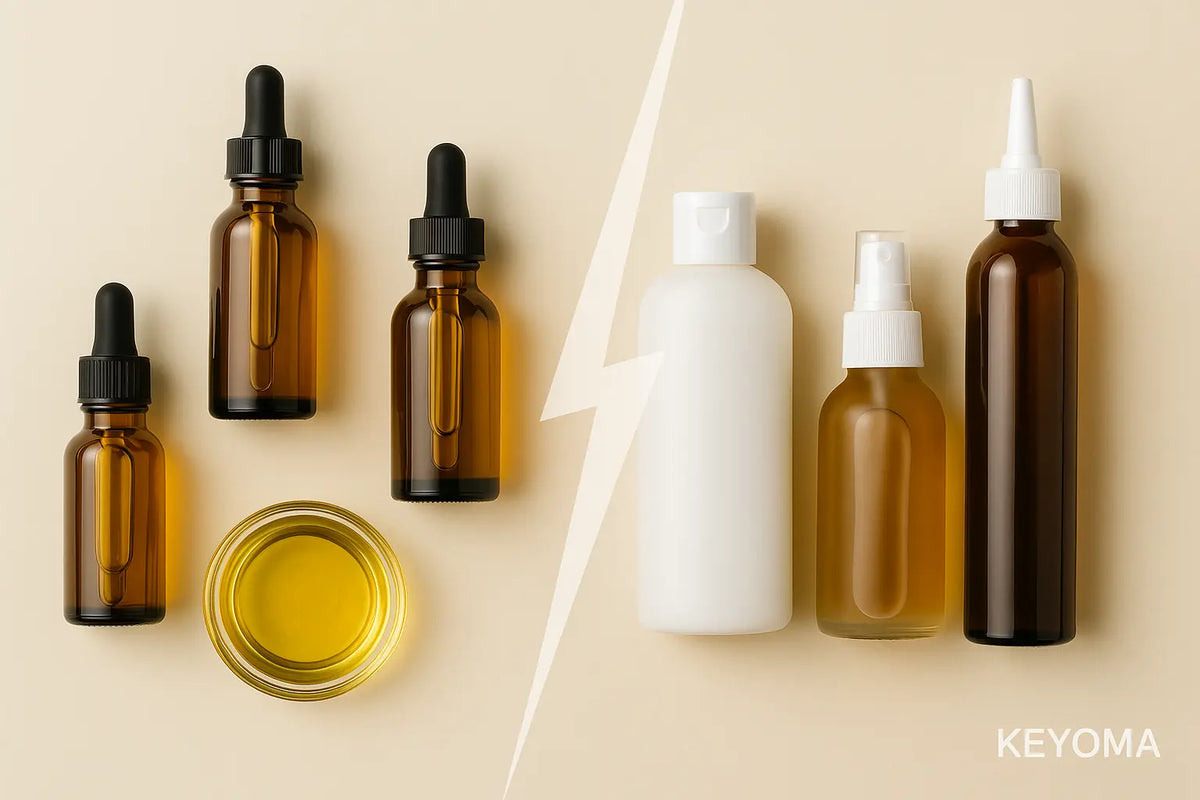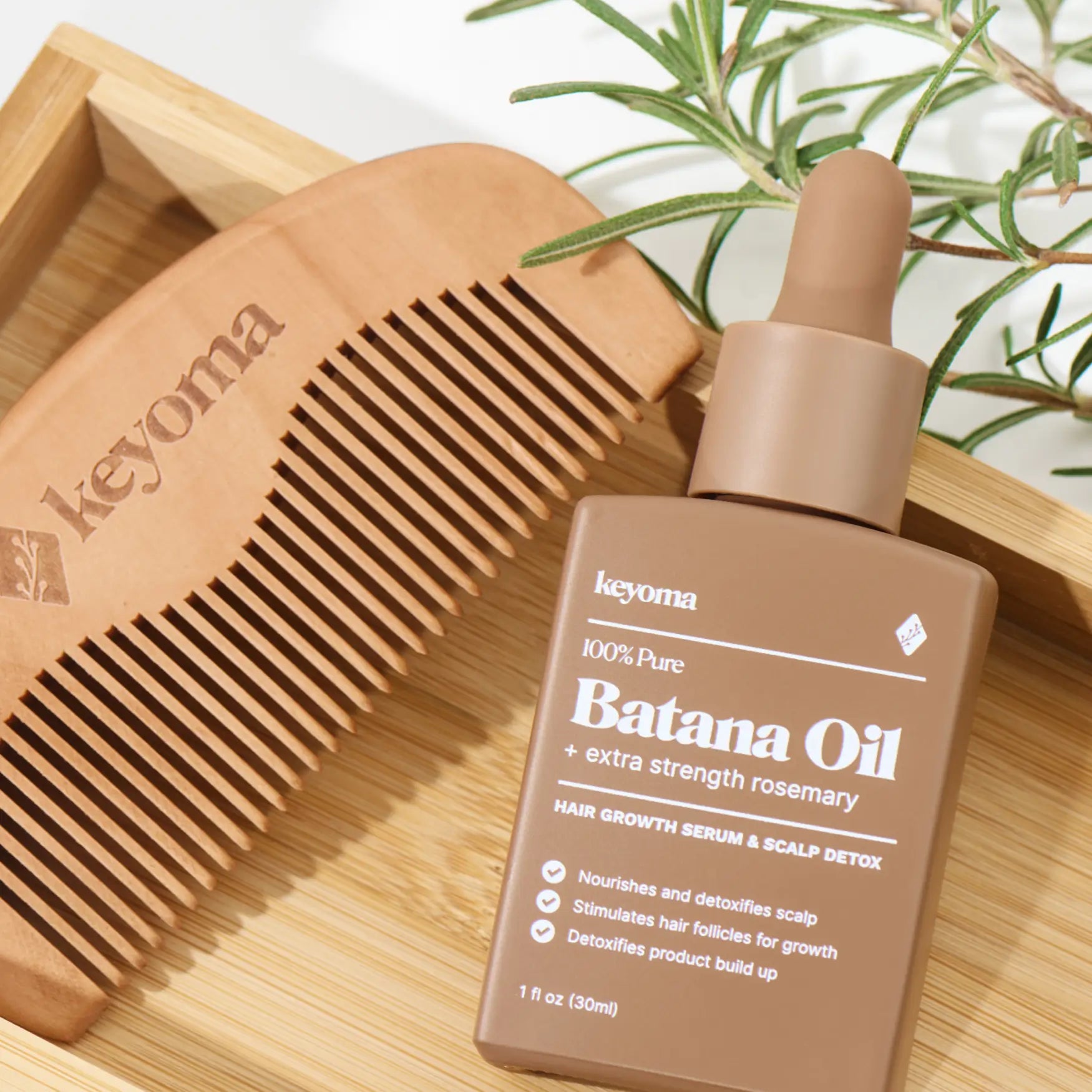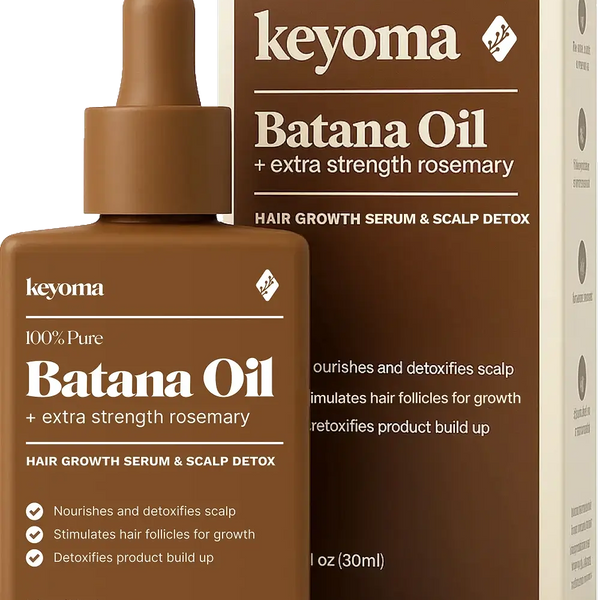In this article
If you’ve ever stood in front of your vanity holding two bottles—one labeled hair oil and the other hair tonic—wondering which one your hair actually needs, you’re not alone. They sound similar, both promise healthier hair, and both get tossed around in every hair-care conversation.
In this guide, we’ll unpack what really sets hair oils and hair tonics apart, when to use each one, and how to pair them for the best results. Because once you understand how the two work together, your routine starts feeling less like guesswork and more like a real strategy for growth.
What Is Hair Oil?
Hair oil is a nutrient-rich blend packed with fatty acids, antioxidants, and vitamins. These nutrients replenish lost moisture, soften brittle ends, and give your strands that supple, touchable feel most conditioners can’t match.
But beyond fixing surface-level damage, some oils, especially those made from botanical or plant extracts, have shown to work deep into the roots and produce real hair regrowth.
Take rosemary oil, for example. Studies have found its performance comparable to 2% minoxidil, the standard hair regrowth drug. Peppermint oil, on the other hand, helps boost scalp circulation through vasodilation, delivering more oxygen and nutrients to follicles.
All this shows that hair oiling isn’t just a beauty ritual passed down through generations; it’s a hair care method supported by biology.
As for how to use it, many apply oil as a pre-poo step (before shampooing) to protect the hair from drying shampoos. Others prefer using a few drops post-wash to smooth ends or tame frizz throughout the day.
What Is Hair Tonic?
Hair tonic is a liquid-based scalp solution designed to refresh, stimulate, and balance the scalp. It’s usually water or alcohol-based, sometimes infused with botanical extracts like witch hazel, ginseng, or peppermint, and in more modern versions, caffeine and niacinamide.
It originally rose to fame in barbershops, used after a cut to cool the scalp and style the hair. But today’s hair growth tonic formulas go far beyond that.
They’re often lightweight leave‑ins meant to support follicle health, reduce flakes, or balance excess oil production, especially in routines focused on ph‑balanced scalp care or DHT‑friendly botanicals.
Most people apply it directly to the scalp (not the strands), usually after towel drying. Some versions, like caffeine scalp spray, are meant for daily use and don’t require rinsing. Others, especially ones with active ingredients for dandruff or irritation, may follow a 3‑times-a-week rhythm.
Key Differences Between Hair Oil vs Hair Tonic
Composition & Formula Base
Hair oils are typically lipid-based. That means their foundation is made up of fatty acids, natural oils, and sometimes fat-soluble vitamins like A and E. These oils, whether coconut, batana, castor, or jojoba, are meant to coat the hair strand, mimic sebum, and create a moisture-locking barrier.
Hair tonics, on the other hand, are water or alcohol-based solutions. They often contain lighter active ingredients like caffeine, witch hazel, niacinamide, or botanical distillates designed to absorb into the scalp quickly. While some newer formulas include a bit of oil, the concentration is usually minimal.
Primary Focus Area
Hair oil is often used to hydrate and protect the strands. It wraps around the cuticle, smooths split ends, and shields hair from breakage, frizz, or sun damage.
But depending on the formulation, especially with botanical-rich oils like rosemary or batana, it can also work deeper by nourishing the scalp, soothing dryness, and even supporting healthy follicle function.
Hair tonic, on the other hand, is more scalp-specific by design. It’s applied directly at the roots to refresh, balance sebum levels, and deliver lightweight actives like caffeine or niacinamide that help energize the follicle base.
Many people turn to tonics for oily scalp, flaking, or to stimulate growth without adding weight to the hair.
Absorption & Residue
Hair oil tends to sit on the surface of the hair and scalp longer, especially if it's made with heavier oils like castor or coconut. While this helps seal in moisture and protect strands, it can also leave behind a greasy or slick texture, especially when over-applied or not rinsed out after a pre-poo.
Oils with smaller molecules, like jojoba or argan, absorb faster and feel lighter, but even those can weigh down fine hair if used too liberally.
Hair tonic, by contrast, absorbs quickly. Most tonics are water or alcohol-based, so they evaporate fast and don’t leave behind any noticeable film. That’s why they’re often favored by people who want a clean, non-greasy feel.
Application Timing & Use Frequency
Hair oils are most often used as a pre-wash treatment or overnight mask. Many apply them 30 minutes to a few hours before shampooing to minimize dryness from clarifying shampoo. Heavier oils like castor or coconut are better suited for these longer treatments.
At times, hair oils can be used much like hair serums. Lighter oils like jojoba or rosemary, for example, can be used in small amounts after washing, especially on the ends for frizz control and added shine.
Hair tonics, on the other hand, are typically applied after washing, directly onto towel-dried scalp. Since they’re non-greasy and absorb quickly, they can be used daily, especially if you're using a caffeine scalp spray or tonic aimed at stimulating follicles.
Risks
Hair oil can cause clogged pores or greasy buildup on the scalp if over-applied, especially for people with fine hair or oily roots. Oils like castor or coconut are heavy, and when used in excess, they may trap heat or sweat, making the scalp feel itchy or weighed down.
There’s also the risk of product buildup if oils aren't fully rinsed out, and this often leads to dull strands or scalp health issues.
Hair tonic, particularly those with alcohol or strong botanical extracts, can dry out sensitive scalps or cause stinging if the skin barrier is compromised. Daily use of alcohol-heavy tonics may also lead to a tight or itchy feeling in some users.
In very rare cases, allergic reactions to certain herbs or actives like menthol, caffeine, or niacinamide can also occur.
For both products, patch testing and moderation are key. And when in doubt, keep your routine simple. Start small, listen to your scalp, and adjust based on how it reacts.
Suitability by Hair or Scalp Type
Hair oil tends to suit those with dry, brittle, or high-porosity hair—basically, anyone whose strands need extra help holding onto moisture. It’s also ideal for people with coarse or curly hair types, where frizz control and softness are daily struggles.
However, those with oily scalp or fine, limp strands may need to choose lighter oils like jojoba for scalp care or rosemary hair oil in small amounts to avoid feeling greasy.
Hair tonic is generally better suited for people with oily or irritated scalps, or those dealing with itchiness, flakes, or excessive sebum. It’s also perfect for fine or thinning hair since most tonics are lightweight and non-oily.
Which is Better, Hair oil or Hair Tonic?
Between hair oil and hair tonic, one isn’t inherently better than the other. The better choice really depends on what your hair and scalp need most.
If your strands feel rough, frizzy, or overly dry, a nourishing hair oil is what helps bring back moisture and strengthen the cuticle.
Hair tonic, on the other hand, works best if you’re dealing with itchiness, excess oil, dandruff, or sluggish growth caused by buildup or poor circulation. Because it’s lightweight and fast-absorbing, it fits easily into daily routines without leaving the hair sticky or heavy.
In many cases, both can actually complement each other. Tonic to refresh and balance the scalp, and oil to nourish and protect the lengths.
And that leads us perfectly to the next point...
Can I Use Hair Oil and Hair Tonic Together?
Yes, you can use hair oil and hair tonic together. They serve different functions, and when paired properly, they can create a balanced routine that supports both scalp and strand health.
The main principle is simple: tonic first, oil second.
Hair tonic targets the scalp, helping to cleanse, refresh, and deliver lightweight actives like caffeine or herbal extracts that stimulate and balance follicles. Hair oil, meanwhile, nourishes and seals moisture into the hair strands, protecting them from dryness or environmental damage.
Here's how to use hair oil and hair tonic together:
-
Start with a clean scalp. After shampooing and towel-drying, apply your hair tonic directly to the scalp. Massage gently using your fingertips to boost circulation and ensure the liquid absorbs well.
-
Let it absorb. Wait a few minutes for the tonic to settle into your scalp and begin its work.
-
Follow with oil. Once the tonic is absorbed, apply a small amount of oil to the lengths and ends of your hair. If you’re using a lightweight oil like jojoba or rosemary, you can also gently massage it into the scalp without interfering with the tonic.
-
Adjust to your routine. Use this combo once or twice weekly for deeper care, or alternate between them daily depending on your scalp’s condition.
Frequently Asked Questions (FAQs)
Is hair tonic the same as serum?
No, hair tonic isn’t the same as serum. A hair tonic is made for the scalp and it’s water or alcohol-based, meant to refresh, balance, and stimulate the follicles. A hair serum, on the other hand, focuses on the strands. It coats and smooths the outer layer to tame frizz, add shine, and protect from heat or humidity.
Can I sleep with hair oil on?
Yes, you can sleep with hair oil on as part of an overnight treatment. Oils like batana, coconut, or castor work especially well for this. Just make sure it doesn’t stay on for more than 24 hours, since leaving it too long can clog follicles and attract dirt or irritation.
Can I use hair tonic on color‑treated hair?
Yes, most hair tonics are safe for color‑treated hair as long as they’re alcohol‑free or formulated with gentle, pH‑balanced ingredients. Many modern tonics use botanical extracts like rosemary, ginseng, or niacinamide that actually help keep the scalp healthy without stripping color.
If your hair is freshly dyed, avoid tonics with high alcohol content or strong astringents, since these can dry the strands or fade pigment faster.
Which is better for dandruff, hair oil or hair tonic?
Hair tonic generally works better for dandruff when the cause is excess oil, yeast buildup, or an imbalanced scalp microbiome. Tonics are formulated with lightweight actives that don't clog pores.
Hair oils, however, can help if the dandruff is linked to dryness rather than buildup. Oils rich in anti‑inflammatory or antimicrobial compounds, such as batana or coconut oil, can soothe a tight, flaky scalp and reduce visible flakes when used sparingly.
Use Both Hair Oil and Hair Tonic. Just Use Them Right.
Hair oil and hair tonic each play a different role, but they're not mutually exclusive. You can use both in the same routine. Hair tonic for the scalp and oil for the strands.
If you’re just getting started, keep it simple. For hair oil, batana oil is a strong all-around pick, especially if you’re looking to nourish and strengthen (my hair's been loving this one for years!). Coconut and jojoba are also reliable classics if that’s what’s already on your shelf.
For tonics, look for scalp-friendly ingredients like caffeine, rosemary, or niacinamide, and go for alcohol-free formulas if your scalp is on the sensitive side.
Want more tips like this? Head over to the Keyoma Blog where we break down hair routines, ingredients, and what actually works!
Featured Product
100% Pure Batana Oil + Rosemary









